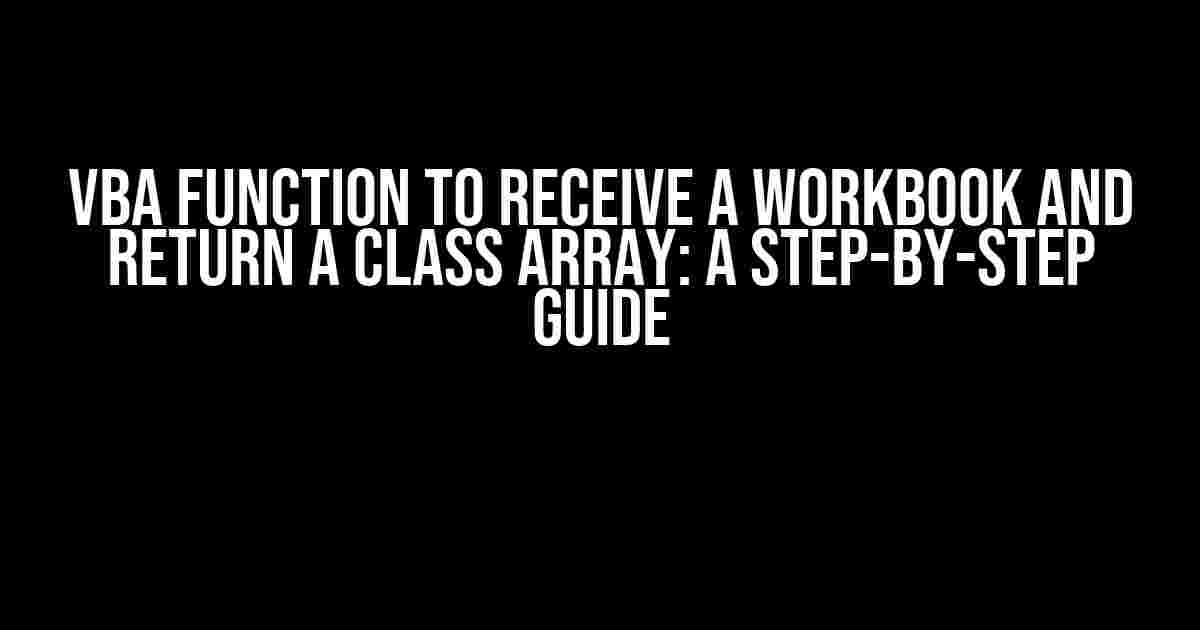Are you tired of dealing with tedious data processing in Excel? Do you want to take your VBA skills to the next level? Look no further! In this article, we’ll explore the ins and outs of creating a VBA function that receives a workbook and returns a class array. By the end of this tutorial, you’ll be equipped with the knowledge and expertise to create custom solutions that streamline your data processing tasks.
What is a Class Array and Why Do We Need It?
A class array is a data structure that allows you to store and manipulate complex data in a flexible and efficient manner. In the context of VBA, a class array is an array of objects that can contain multiple properties and methods. By using a class array, you can create custom data structures that are tailored to your specific needs, making it easier to work with large datasets.
The Benefits of Using a Class Array
- Improved data organization and structure
- Flexibility to add or remove properties and methods as needed
- Enhanced data manipulation and analysis capabilities
- Simplified data exporting and importing
Creating the Class Module
Before we dive into the VBA function, we need to create a class module to define the structure of our class array. Open your Visual Basic Editor (VBE) and follow these steps:
- In the VBE, go to
Insert>Class Module. - In the
Class Module, rename the module tocWorkbookData. - Add the following properties to the class module:
Private pWorkbook As Workbook Private pSheet As Worksheet Private pData As Variant
These properties will store the workbook object, the active sheet, and the data range, respectively.
The Class Module Code
Option Explicit
Private pWorkbook As Workbook
Private pSheet As Worksheet
Private pData As Variant
Public Property Get Workbook() As Workbook
Set Workbook = pWorkbook
End Property
Public Property Let Workbook(value As Workbook)
Set pWorkbook = value
End Property
Public Property Get Sheet() As Worksheet
Set Sheet = pSheet
End Property
Public Property Let Sheet(value As Worksheet)
Set pSheet = value
End Property
Public Property Get Data() As Variant
Data = pData
End Property
Public Property Let Data(value As Variant)
pData = value
End Property
The VBA Function to Receive a Workbook and Return a Class Array
Now that we have our class module set up, let’s create the VBA function that receives a workbook and returns a class array. In a new module, add the following code:
Option Explicit
Public Function GetWorkbookData(wb As Workbook) As cWorkbookData()
Dim dataArr() As cWorkbookData
Dim ws As Worksheet
Dim i As Long
ReDim dataArr(1 To wb.Worksheets.Count)
For i = 1 To wb.Worksheets.Count
Set ws = wb.Worksheets(i)
Set dataArr(i) = New cWorkbookData
Set dataArr(i).Workbook = wb
Set dataArr(i).Sheet = ws
dataArr(i).Data = ws.UsedRange.Value
Next i
GetWorkbookData = dataArr
End Function
This function takes a workbook object as an argument and returns an array of cWorkbookData objects. It iterates through each worksheet in the workbook, creates a new instance of the class module, and sets the properties accordingly.
How to Use the VBA Function
To use the GetWorkbookData function, simply pass a workbook object as an argument, like this:
Dim wb As Workbook Set wb = ThisWorkbook Dim dataArr() As cWorkbookData dataArr = GetWorkbookData(wb)
This will return an array of cWorkbookData objects, each containing the workbook, sheet, and data range information.
Example Usage and Tips
Here’s an example of how you can use the returned class array to iterate through the data:
For i = LBound(dataArr) To UBound(dataArr)
Debug.Print dataArr(i).Sheet.Name & ": " & dataArr(i).Data(1, 1)
Next i
This will print the sheet name and the value of the top-left cell of each data range.
Tips and Variations
- Use the
cWorkbookDataclass to create custom data structures tailored to your specific needs. - Modify the
GetWorkbookDatafunction to accept additional arguments or parameters. - Use the
GetWorkbookDatafunction to create data visualization tools or dashboards. - Integrate the
GetWorkbookDatafunction with other VBA tools and libraries for enhanced data analysis and processing.
Conclusion
In this article, we’ve explored the creation of a VBA function that receives a workbook and returns a class array. By leveraging the power of class modules and arrays, we can create custom data structures that simplify data processing and analysis. With this knowledge, you’re now equipped to take your VBA skills to the next level and create innovative solutions that streamline your data processing tasks.
Future Development and Expansion
In future articles, we’ll explore additional techniques and applications of class arrays in VBA, including:
- Using class arrays with API data and web scraping
- Creating data visualization tools with class arrays
- Integrating class arrays with machine learning and AI models
Stay tuned for more exciting VBA tutorials and guides!
Frequently Asked Question
Get ready to unleash the power of VBA and dive into the world of class arrays!
How do I declare a VBA function to receive a workbook and return a class array?
You can declare a VBA function to receive a workbook and return a class array by using the following syntax: `Function GetClassArray(wb As Workbook) As MyClassName()`. Here, `MyClassName` is the name of your class module, and the parentheses `()` indicate that the function returns an array of that class type.
What is the purpose of using a class array in VBA?
Using a class array in VBA allows you to create a collection of objects that can be manipulated and processed as a single unit. This is particularly useful when working with large datasets or complex data structures, as it enables you to encapsulate data and behavior in a modular and reusable way.
How do I populate a class array in VBA?
You can populate a class array in VBA by using a loop to iterate over the elements of the array and assigning values to each element. For example, you can use a `For Each` loop to iterate over the worksheets in a workbook and create a new instance of your class for each worksheet, assigning it to the corresponding element in the array.
What is the benefit of using a class array over a regular array in VBA?
Using a class array over a regular array in VBA provides several benefits, including the ability to encapsulate data and behavior, create reusable code, and take advantage of inheritance and polymorphism. Class arrays also enable you to work with complex data structures in a more modular and maintainable way.
How do I return a class array from a VBA function?
To return a class array from a VBA function, you can use the `As` keyword to specify the return type of the function, followed by the name of the class module and the parentheses `()` to indicate an array. Then, within the function, create a new instance of the class array and populate it with data before returning it to the caller.



